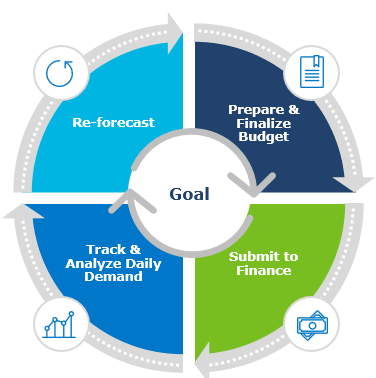A conversation with Carl Weldon, COO Europe, Hospitality Financial and Technology Professionals (HFTP).
For over 30 years, IDeaS has empowered hotels to increase RevPAR, optimize business mix and enhance productivity. Central to this has been hotels successfully utilizing accurate forecasts and distributing optimal pricing and revenue management strategies.
However, a post-COVID recovery demands the industry look increasingly toward a more holistic approach to hotel forecasting and budgeting, going beyond guest rooms to a more scientific forecast of the entire business, including food & beverage (F&B) and ancillary revenue streams, to drive maximum revenue performance.
We often characterize departmental silos in hotels as: revenue management striving for agile forecasting and optimal pricing, and sales, marketing and operations wanting “one source of the truth” in reporting. But the demands of the organization’s finance leader to deliver operational efficiency and bottom-line profit makes them the ultimate stakeholder to satisfy.

Of course, the status quo is very manual. Regular production of annual budget and financial forecasts monthly or quarterly can be a labor-intensive process. Typically, revenue managers can spend several hours each week completing mundane tasks in Excel, with time and data quality often compromised.
We know F&B forecasting is mainly guesstimating. Due to the complexity and amount of data generated, forecasting for non-rooms revenues like F&B lacks the same sophistication as rooms. This is compounded further if F&B outlets are co-owned and spread throughout the organization. Add in the manual effort involved with forecasting banquet and catering business we can get a sense of the task ahead, all leading to imprecise planning and inefficient staffing, ultimately leaving profits on the table.
So how do we begin to address this seemingly overwhelming challenge? To tackle this issue, I turned to Carl Weldon, former hotel executive and HFTP’s chief operating officer, Europe, for his perspective.
Neil Corr (NC): Carl, you and I have worked across multiple hotel groups and industry associations over the years, but in your various positions as finance leader, what was the common denominator when it came to problems with forecasts at the total hotel level?
Carl Weldon (CW): The main problem with forecasts was local or regional management understanding the vagaries of their markets—events and local happenings, or annual differences therein—and so were often missed or not considered. A forecast is not just a straight line with an increase built-in; it needs local, up-to-date knowledge.
NC: Now as HFTP’s COO, what are the common themes you hear from finance and IT leadership regarding streamlining the budget process, and what have been some of the successes you’ve observed?
CW: The industry does not tend to share its budgeting experience well 😊. “Spreadsheet hell” can be a theme, plus a lack of central leadership (in hotel group environments) on providing information on centrally decided costs and the like. Budgets are a commitment to achieve—not just another forecast—and sometimes this key message can be lost in the budgeting negotiations.
There are more advanced budgeting distributed systems available of course now, but at a price, and so they’re really only available to large hotel groups.
NC: What should a hotel company prioritize if they want to achieve a holistic approach to budgeting?
CW: A company can be one or multiple hotels or units of course. This will change the approach depending on how centralized the revenue management and marketing functions are. I once ran the budgeting process for a 122-hotel company across multiple regions and brands, with owned and managed hotels within it. We spent a fair amount of time in advance developing the Excel model, getting it tested and then trained in, plus we built a budget book (paper at the time) for all centrally built cost assumptions. We then built in an ability to import all the budgets into an OLAP (Online Analytical Processing) for easy data comparisons, graphics and presentation at higher (group) levels.
The key message here is: you do need to plan the budget process, and someone needs to take ownership of that process.
NC: What are the best and worst examples you’ve seen of cross-functionality forecasting and budgeting?
CW: I think the worst examples were always where—clearly—the general manager or function leader had not really stepped back and looked at what the proposed budget was saying at the top level. Always a lot of detail (normally negative) with a “well, that’s the result” type of attitude.
The best examples were normally the reverse of the above—a team with a plan! Any spreadsheet or system can be fixed, but the human approach is always the most important.
NC: To what degree do you see poor data integrity and financial data structures as inhibiting factors in advancing the forecasting and budgeting process in hospitality, and how can we overcome this?
CW: The example above of the 122-hotels group was a classic. We spent much of my initial time there debating various results and comparisons that were either wrong or only available to certain people—and always on “another spreadsheet.”
Once we set up our OLAP database and had one version of the truth for all—continuously updated as it happened—it all became much smoother. Also, once we distributed the data with graphs to those who managed on the front-line, the results showed up on many things previously missed. Lastly, focus on the history and review the information. Graphs are a great help here as any obvious errors will jump right out at you.
NC: What are primary objectives for HFTP over the next year in addressing the industry’s pressing issues and finding solutions to the challenges ahead?
CW: HFTP’s objective is to “To lead and advance the hospitality profession by providing a forum for continuous learning and knowledge sharing.” We are consistently working toward that objective, but clearly in this COVID environment it has become difficult to present these resources as usual. Rather we have quickly adapted our format of delivery because these resources are even more important today.
HFTP has built up its digital education and networking programming via a robust schedule of webinars and HFTP Hangouts (interactive Zoom gatherings for Europe and U.S.). These have enabled those who work in our industry to come together and discuss issues and challenges, which is very important.
And of course, for 2020, we are still able to have HITEC, but virtually through Cyber HITEC starting on October 27. This will allow people to do all this—meet and find solutions—live for three days and on-demand for a month.
Looking at the long term, HFTP has just introduced a digital subscription service for the Uniform System of Accounts for the Lodging Industry (USALI). This makes it easier to access on a variety of media devices across the globe. We have also introduced a USALI Certificate program to promote the importance of expertise on the standards.

NC: So, it appears we can predict—or I should say, forecast—plenty of light at the end of the tunnel. The journey from cumbersome budgeting and forecasting processes that mainly hinge on Excel, to the final destination of precise planning and budgeting will be a difficult one, but one we can surely reach.
In the context of the ultimate goal of total hotel revenue optimization, we see how rooms forecasting today achieves part of this through revenue management. Can we foresee this same standardization and automation to deliver holistic forecasting and budgeting of the entire business in the years to come?
